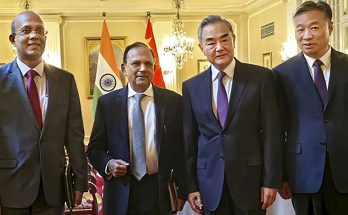
By Guan Peifeng
The Galwan Valley has always been a part of the Chinese territory and is located in Hetian County, Xinjiang Uygur Autonomous Region, China. Before 1962, the Indian army had never been to this area. In early May of this year, since the confrontation between the border forces of China and India, the Galwan Valley began to appear frequently in Chinese and foreign media reports. On the evening of June 15, Indian border troops once again crossed the Line of Actual Control in the Galwan Valley with provocation, causing fierce physical clashes and casualties on both sides. The Galwan Valley is the focus of attention of both Chinese and Indians.
It is not the first time that the Galwan Valley has become the focus of attention. The history can be traced back to the China’s border self-defense counterattack to India in 1962. After the independence, India inherited the mantle of British colonialism. Since the 1950s, the Indian government took the advantage of the difficulties faced by the People’s Republic of China, and carry out the “forward policy” in the Sino-India border to invade the Chinese territory. At that time, the Chinese government was busy for the Resist-America-Aid-Korea movement, and faced the deterioration of Sino-Soviet relations. In July 1954, India blatantly revised the map, marking all previous undefined borders as delimited, and eroded the Sino-Indian border continuously. In August and October 1959, the Indian army provoked two bloody clashes in the eastern and western sectors of the Sino-Indian border. In order to prevent the escalation of the conflict, on November 7, 1959, Premier Zhou Enlai wrote to Nehru, suggesting that the armed forces of both sides withdraw 20 kilometers and stop patrolling along the Line of Actual Control at that time, but these reasonable suggestions were arbitrarily rejected by India. To avoid border conflicts, China unilaterally stopped border patrols. However, the Indian troops took advantage of this gap to continue to erode towards the Chinese side.
On July 6, 1962, the Indian army invaded the Galwan Valley and advanced to a location only about one hundred meters from the Chinese patrol. The Chinese patrol always kept restraint and took the initiative to retreat a certain distance to avoid serious incidents. However, the Indian troops that invaded the Galwan Valley, ignoring the Chinese government’s strong protests, not only refused to retreat, but continued to provoke with more troops. They even established new aggression strongholds behind the Chinese posts, which further threatened the security of the Chinese troops. By October 1962, the Indian Army set up as many as 43 strongholds on the Chinese side of the western sector of the Line of Actual Control.
On October 20, 1962, the Chinese border troops, unable to retreat and beyond endurance, were forced to fight back in self-defense. They uprooted all the 43 aggressive positions set up by the Indian army in the Western sector of Line of Actual Control, including all the positions in the Galwan Valley. China launched a defensive counterattack in the hope of forcing India back to the negotiating table and has no intention of resolving border disputes through war. In the face of overall victory on the battlefield, the Chinese border troops retreated to the Chinese side of the Line of Actual Control proposed on November 7, 1959 on its own initiative. On the western part of the China-Indian border, China only retained a few outposts in the areas of the Galwan Valley, the Kongka Pass and the Pangong Lake. For a long time, the Galwan Valley has been under China’s actual control.
Despite major defeats they suffered on the battlefield, India has never abandoned its “forward policy.” Instead, it took advantage of China’s retreat to regain territory. Since April this year, the Indian border troops have unilaterally been building roads and bridges in the Galwan Valley which is approaching the Chinese side of the Line of Actual Control, ignoring China’s repeated representations and protests. The Indian Army has stepped up its efforts to cross the line into Chinese territory and set up barriers to stop the normal patrol of Chinese border troops in an attempt to unilaterally change the status quo. With the active promotion and efforts of China, Chinese and Indian border Troops held the First Commander-Level Meeting since the Galwan Valley clash and agreed to take measures to alleviate the tension. The Indian side promised to withdraw the personnel and dismantle the facilities in the Galwan Valley and not to patrol or build facilities across the river mouth of Galwan River.
As the situation in the Galwan Valley tends to ease and China is actively implementing the consensus reached at the China-India Commander-Level Meeting, it is shocking that on the evening of June 15, the Indian front line troops went against the agreement reached at the Commander-Level Meeting, crossed the Line of Actual Control again and violently attacked the Chinese soldiers who went to negotiate with them, causing violent physical clashes and casualties. The rights and wrongs of this incident are very clear and the responsibility rests entirely with the Indian side.
In recent years, India has maintained an aggressive posture on the boundary issue. It can be reflected from border dispute with China, and its South Asian neighbours. India unilaterally published its new map in 2019 and incorporated Kalapani which is still disputed with Nepal inside India’s territory. In May this year, Indian government announced the inauguration with great fanfare of a road project which passes through the disputed area, provoking strong opposition from all over Nepal. The Government of India announced abolishing the Article 370 of the Indian constitution, revoking the autonomous status of Jammu and Kashmir, bifurcating the India occupied Kashmir into two separate union territories of Jammu and Kashmir, and Ladakh. Such acts incorporated all disputed territories with Pakistan and China into Indian administrative divisions. The series of actions violated norms in international relations and relevant Security Council resolutions. India also classifies such kind of unilateral disposal of disputed territories as internal matters blatantly, exacerbating the relations with other regional countries severely. India has become the source of turmoil across the South Asian subcontinent, who brings about serious negative effects on regional peace and stability.
By contrast, China has demarcated boundary with 12 of its 14 neighboring countries (except India and Bhutan) through peaceful negotiations, and is strengthening interconnection with neighboring countries through the “Belt and Road” initiative, turning land borders into bonds of friendly cooperation. The Chinese people love peace and have firm confidence in defending their own territorial sovereignty, but they have no desire to covet the territory of other countries. Regarding the disputed territory, China has always advocated that on the basis of respecting international law to settle border disputes peacefully. It is necessary to respect history as well as reality, and fully take into account the national feelings of people, through friendly negotiations, mutual understanding and concessions.
The history of China-India relations over the past 70 years has proved that cooperation benefits both while confrontation hurts two. Whether it is in the Galwan Valley or elsewhere on the Sino-Indian border, China has never been a provocateur. Unable to retreat and beyond endurance, China fought a political-military warfare to force India back to the negotiating table in 1962. Today, 58 years later, while sticking to its bottom line, China still hopes to live in peace with India, manage differences properly through dialogue. We hope India meet China halfway, keep calm and exercise restraint like China as well as resolve conflicts peacefully through dialogue and negotiation, so that both sides can ease tension and jointly uphold peace and stability in the border areas.
(Guan Peifeng is with Wuhan University China Institute of Boundary and Ocean Studies)
(Disclaimer: The views expressed in this article reflect solely those of the author, and not that of the publisher)



